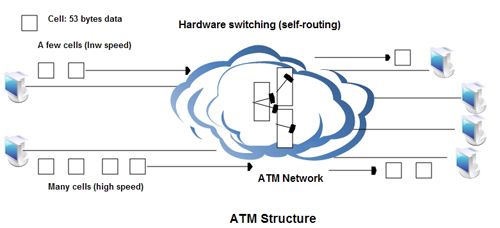The purpose of ATM is to provide high speed, low-delay multiplexing and switching networks to support any type of user traffic, such as voice, data or video applications. This is specifically designed as single technology for voice, video, and data.
ATM segments and multiplexes use traffic into small, fixed length units called cells to reduce and control delay and enable most of the switching (routing) within the network to be processed by the hardware. Hardware switching allows the transmission paths within the ATM network to look as if the cells themselves determined them. Therefore, ATM routing is referred to as self-routing. In ATM transmission, changing the cell transmission volume per cell unit of time allows, in terms of appearances, the data transmission speed to be determined freely.
This enables ATM to simultaneously send data that does not demand immediacy (such as mail data) as well as data that does demand immediacy (such as voice data and image data). Therefore, ATM can support different speeds, traffic types and quality of service matched to applications. ATM cells coming from a user are guaranteed delivery at the other end with a high probability and low delay.

Characteristics of ATM
- The transport speeds of most ATM applications are most often 155Mbps and 622 Mbps.
- ATM is a flexible service made possible by the size of the packets (cells). The cell size for all applications is 53 bytes.
- The small cell size allows a variety of applications to run on ATM networks including voice, video, and data. The appeal of the service has to do with the ability to pass voice and video information. These two services are time sensitive or otherwise known as isochronous data. This means that voice and video are susceptible to time delays. The small cell size of ATM and the service options such as Continuous Bit Rate Service allow such traffic to flow over the network where others such as Frame Relay and SMDS cannot guarantee this level of service.
 Dinesh Thakur holds an B.C.A, MCDBA, MCSD certifications. Dinesh authors the hugely popular
Dinesh Thakur holds an B.C.A, MCDBA, MCSD certifications. Dinesh authors the hugely popular